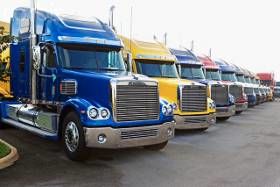New! High Road 2.0! We have a new version of this program. You can find it here: High Road 2.0
2.3 Shifting Gears
Manual Transmissions
Correct shifting of gears is important. If you cannot get your vehicle into the right gear while driving, you will have less control. Most heavy vehicles with manual transmissions require double clutching to change gears.
Best method for shifting up:
- Release accelerator, push in clutch and shift to neutral at the same time.
- Release clutch.
- Let engine and gears slow down to the RPM required for the next gear (this takes practice).
- Push in clutch and shift to the higher gear at the same time.
- Release clutch and press accelerator at the same time.
Shifting gears using double clutching requires practice. If you remain too long in neutral, you may have difficulty putting the vehicle into the next gear. If so, do not try to force it. Return to neutral, release clutch, increase engine speed to match road speed, and try again.
Knowing When to Shift Up
Use engine speed (RPM):
Study the driverʼs manual for your vehicle and learn the operating RPM range. Watch your tachometer, and shift up when your engine reaches the top of the range. (Some newer vehicles use “progressive” shifting: the RPM at which you shift becomes higher as you move up in the gears. Find out whatʼs right for the vehicle you will operate.)
Use road speed (mph):

Learn what speeds each gear is good for. Then, by using the speedometer, you will know when to shift up.
With either method, you may learn to use engine sounds to know when to shift.
Best Method for Shifting Down
- Release accelerator, push in clutch and shift to neutral at the same time.
- Release clutch.
- Press accelerator, increase engine and gear speed to the RPM required in the lower gear.
- Push in clutch and shift to lower gear at the same time.
- Release clutch and press accelerator at the same time.
Downshifting, like upshifting, requires knowing when to shift. Use either the tachometer or the speedometer and downshift at the right RPM or road speed.
Special conditions where you should downshift are:
- Before starting down a hill - Slow down and shift down to a speed that you can control without using the brakes hard. Otherwise the brakes can overheat and lose their braking power. Downshift before starting down the hill. Make sure you are in a low enough gear, usually lower than the gear required to climb the same hill.
- Before entering a curve - Slow down to a safe speed, and downshift to the right gear before entering the curve. This lets you use some power through the curve to help the vehicle be more stable while turning. It also lets you speed up as soon as you are out of the curve.
Multi-Speed Rear Axles and Auxiliary Transmissions
Multi-speed rear axles and auxiliary transmissions are used on many vehicles to provide extra gears. You usually control them by a selector knob or switch on the gearshift lever of the main transmission. There are many different shift patterns. Learn the right way to shift gears in the vehicle you will drive.
Automatic Transmissions
Some vehicles have automatic transmissions. You can select a low range to get greater engine braking when going down grades. The lower ranges prevent the transmission from shifting up beyond the selected gear (unless the governor RPM is exceeded). It is very important to use this braking effect when going down grades.
Engine Retarders
Some vehicles have “retarders,” which help slow a vehicle and reduces the need for using the brakes. They reduce brake wear and give you another way to slow down. There are many types of retarders (exhaust, engine, hydraulic, electric). All retarders can be turned on or off by the driver. On some the retarding power can be adjusted. When turned “on,” retarders apply their braking power (to the drive wheels only) whenever you let up on the accelerator pedal all the way.
Caution: When your drive wheels have poor traction, the retarder may cause them to skid. Therefore, you should turn the retarder off whenever the road is wet, icy or snow covered.
Test Your Knowledge
- What are the two special conditions where you should downshift?
- When should you downshift automatic transmissions?
- Retarders keep you from skidding when the road is slippery. True or False?
- What are the two ways to know when to shift?
These questions may be on the written exam. If you cannot answer all of them, study section 2.3
A question about this may come up on the written exam. Be familiar with these two ways of knowing when to shift up (engine speed and road speed).
Understand the ways of knowing when to shift. You can use the tachometer to determine your engine speed (RPM's) or the speedometer to determine your road speed (mph).
You should remember two things here:
- Downshift before starting down the hill.
- You normally need to be in a lower gear than what was required to climb the same hill.
Remember: Slow down to a safe speed before entering a curve.
Engine Retarders (also known as Jake Brakes or Engine Brakes) should never be used during poor roadway conditions. You may have a question on the written exam asking about this.









 TT On Facebook
TT On Facebook